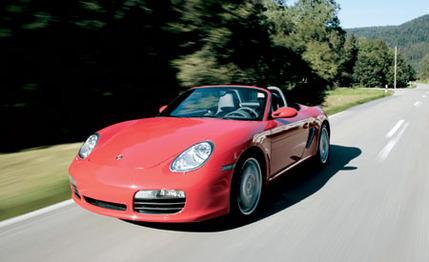 First Drive Review
First Drive Review
Longevity is a quality lacking in the roadster market. Droptop two-seaters are the haute couture of the automotive industry-expensive, ephemeral, and snapped up by Paris Hilton. But roadsters purchased one day are scoffed at the next, as the latest and greatest renders the old obsolete. In this fickle field it's rare for second- or third-year sales to ever duplicate first-year sales.
In light of the competition, it is staggering to consider that the Porsche Boxster has been on sale for eight years. A hot seller from the start, the Boxster managed to maintain its popularity for years and enjoyed a great deal more time in the sun than its competition. Judged on its dynamic merits, the Boxster was good enough to transcend its fashion-conscious segment.
At first glance, the 2005 Boxster looks a lot like the first-generation car, but there are no shared body panels. Wider fenders front and rear bulge out aggressively and were necessitated by a wider track at both ends. In front, the Boxster's headlights have been altered from the previous generation's amoeba-shaped units to a simpler shape that reminds one of the Carrera GT. Around back, the changes are harder to spot without the previous model present for comparison. New taillights and fenders are nearly the same, but the wider rear end is a bit more assertive. Overall, the new look refines the Boxster's strengths while further separating this model from the 911 family.
The most far-reaching changes can be seen in the new interior design. The previous-generation car was often criticized for an interior that was seen as being something less than high quality. Now the Boxster has an interior with a clean, simple dash design. Porsche didn't skimp on the materials this time around. Tightly grained soft-touch plastics mimic leather and make the optional real-leather dash a frivolous option. Furthermore, ovoid vents, easier-to-read gauges, and the new 997 911's center console and tilting and telescoping steering wheel contribute to an interior that feels more expensive and is more comfortable.
For the first time, Porsche is offering a six-speed manual in the base Boxster (a five-speed manual is standard, and as before, the S version comes standard with the six-speed manual). The other transmission choice is the familiar five-speed manumatic Tiptronic S. The manuals benefit from shorter shift throws and a more mechanical feel.
Connected to the gearboxes are two engines that feature revised intake and exhaust systems. Displacement on the base model remains at 2.7 liters, and likewise, the S model is 3.2 liters, but a reworked multistage intake system has released 8 more horses in the base version for a total of 236 horsepower and 18 hiding in the 3.2-liter engine, bringing its total to 276 ponies. The intake system also boosts low-end torque on both engines, giving them greater flexibility. New exhaust systems for both engines evacuate combustion gases more effectively. The S benefits from an equal-length exhaust manifold that further improves efficiency. Porsche provided only the S for our Bavarian driving adventure, and the engine revisions do make it feel a bit more serious, but the powers that be at Porsche have clearly held back on the Boxster so that it does not threaten the superiority of the latest 911.
Like most nine-year-olds, the Boxster's feet are still growing. Bigger wheel wells within the newly sculpted fenders allow for larger-diameter tires, which means for the first time a 19-inch wheel will be offered on a Boxster. Base cars get 17-inch wheels standard-205/55R front and 235/50R rear. The S gets standard 18-inchers, 235/50R front and 265/40R rear, that are optional on the regular-strength Boxster. Shared with the 911 Carrera S are 19-inch wheels wrapped by 235/45R tires for the end that steers and 265/35R for the business end. At launch, the exclusive tire, regardless of size, will be Michelin's griptastic Pilot Sport PS2.
A new front structure necessitated by European offset crash standards widens the track front and rear. The suspension is carried over, with the exception of a few changes for strengthening and lightening. To improve wheel control, the active dampers from the 997 911 are offered as an estimated $2000 option. Also shared with the new 911 is the mechanically variable steering rack, whose ratio becomes faster when you turn the wheel beyond 30 degrees. The ratio change is transparent, and the excellent steering feel of the first Boxster is retained. Tossed through some Black Forest switchbacks on the optional 19-inch tires, the Boxster S feels foolproof because the tires hold on for longer than is reasonable on public roads, but when the tires' relationship with the road is stretched to the limit, the Boxster breaks free as predictably as J.Lo.
There is now a higher level of standard equipment and a larger number to write on your check. Base models begin at $44,595, and the S comes in at $53,895. Porsche is quick to point out that if you had optioned your 2004 Boxster exactly as the base 2005 model is equipped, you'd have spent more than the new car's base price. The '05 Boxster isn't a revolutionary car. Porsche redesigns of successful models never mess with the formula too much, but the meaningful changes that Porsche has bestowed upon the Boxster will surely be enough to keep Hilton and the aficionados happy for another few years.